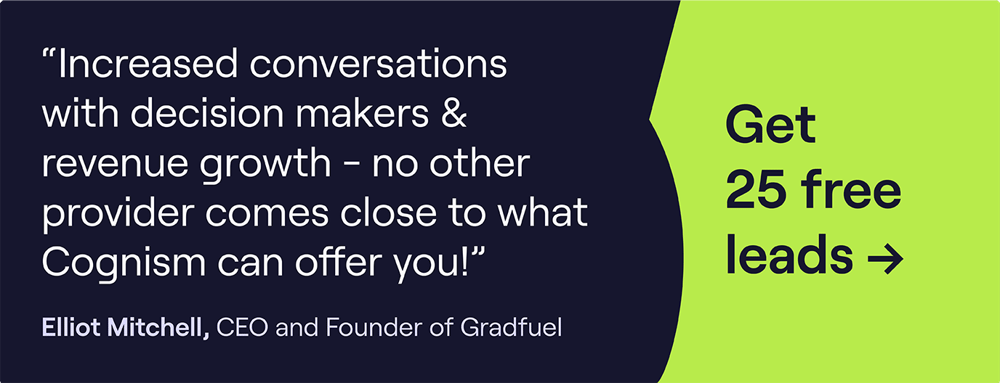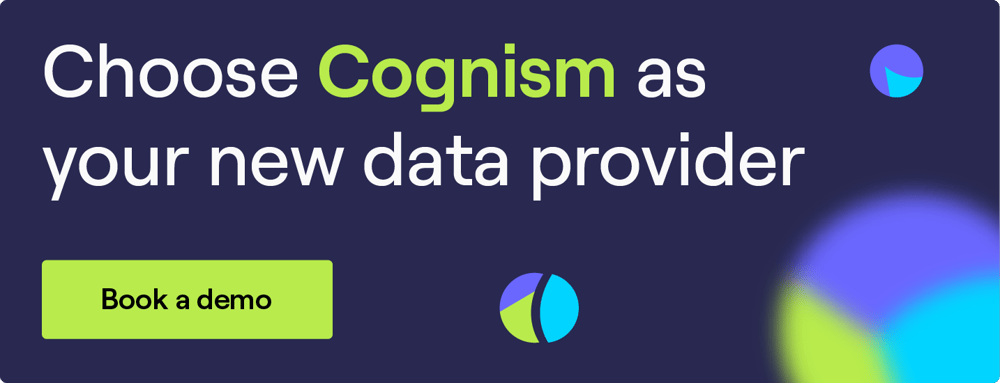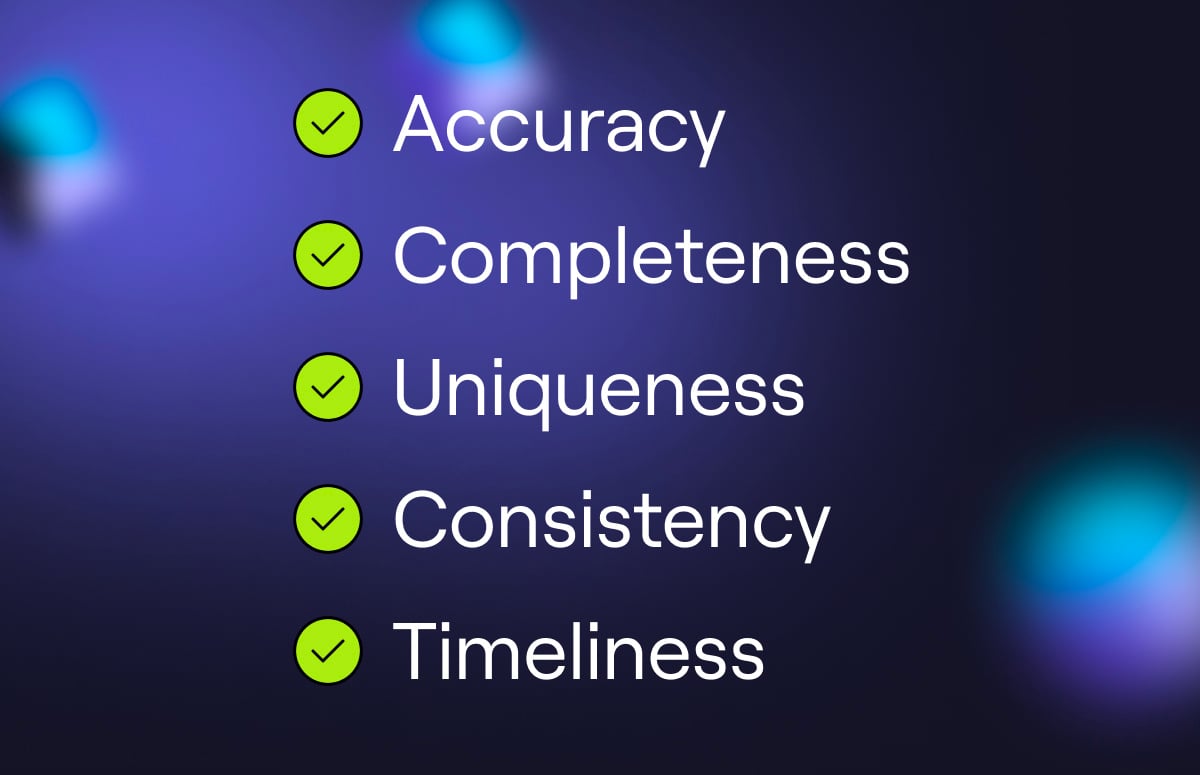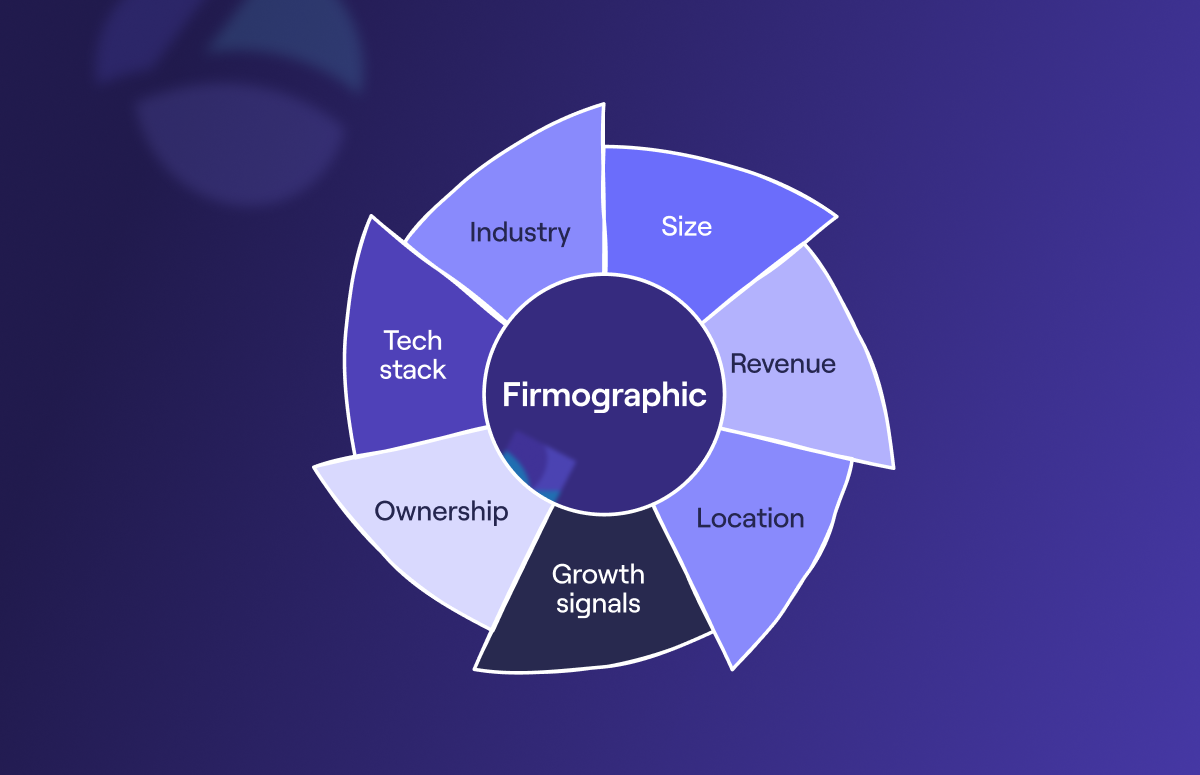Using Account Based Marketing Data for More Revenue
It’s time to end the numbers game.
You know what we mean: MQLs that don’t convert, minuscule conversion rates and lead generation that costs more than you get in return.
What you need is account based marketing data.
Imagine that every potential prospect responded to your outreach. They booked a demo, and a huge percentage of them eventually converted.
For example, with Cognism’s Diamond Data®, you will connect with 87% of your list and land more quality conversations (and eventually more sales).
That’s just one example of how an ABM database can help you, and we’ll dig into more applications and use cases in this article.
Let’s get started 👇
How do you use data for account based marketing?
As you can imagine, data-based marketing can become one of the most effective strategies if applied correctly.
Here are six ways you can use B2B data for effective account based marketing:
1. Create an ABM list
Before you source B2B data for your lists, analyse your best clients with the highest CLV and identify what they have in common. For example, a specific company size, industry, or country can unify them.
Doing this analysis will help you establish an ideal customer profile. Use this information to build and enrich a new list for ABM prospecting.
Here’s an example of how you can use an ABM database like Cognism to do this:
Once you know who you want to target, it’s time to research relevant information about your prospects (their demographics, intent, or firmographic data), anything that makes it easier for you to create personalised messaging.
2. Identify intent
There are two types of ABM data — first-party and third-party intent data. You collect first-party intent data when your prospects fill out things like contact forms on your website.
Third-party intent data analyses search queries and the websites your prospects visit to spot high intent to buy. You can get third-party intent data from account based marketing vendors like Cognism and Lusha.
Here’s an example of how you can target companies searching for a product or service like yours using an ABM vendor.
You can use intent data to personalise your campaigns by answering questions your users might have at every stage of their buyer journey.
Check out how we scaled our ABM program at Cognism. 👇
3. Enrich your database
By enriching and keeping your existing accounts up to date, you can add more information that’s helpful for personalisation, segmentation, and prioritisation.
Choosing a sales intelligence tool that helps you identify incorrect, incomplete, or inaccurate data sets and substitute them with up-to-date ones is crucial for revenue success.
Moreover, you’ll want to add missing information or new fields when working with your ABM sales database. So, choosing a data provider who can help you do that makes sense.
Take durhamlane, for example. They used to use different providers to build their data lists. But, they discovered that this ABM data wasn’t GDPR compliant as the information was often scraped from the internet and contained a mixture of personal and business email addresses.
They decided to enrich their database using Cognism, leading to a 3x increase in conversion rates. They said:
Team Leader @durhamlane
4. Set sales and marketing triggers
You can improve your campaign conversion using contextual data such as new funding, company performance, or changing job roles. Set up the right sales triggers that lead to specific actions, such as launching a new email campaign, performing a call, or sending a message on LinkedIn.
There are various ways to track contextual data that can become your campaign triggers. You can use LinkedIn to track any changes on the organisation level, set up Google alerts for the most important industry events, or identify any funding announcements on your accounts’ websites.
Some ABM data providers include sales and marketing triggers in their packages.
5. Ditch sales and marketing silos
Sales and marketing teams must work closely to make the ABM strategy successful. Getting feedback from both sides on what works and what doesn’t in the process is crucial to improving ABM campaigns.
For this to happen, both teams must maintain open communication channels and regularly catch up on strategy calls. This way, they can find the best way to distribute responsibilities and track progress together.
If your B2B marketing and sales teams aren’t aligned for better account based targeting, you should show initiative and start a dialogue on how to start working together more closely.
6. Measure performance
You can’t improve what you can’t measure — that’s true about account based sales. When it comes to account based marketing data, there is no recipe for success. You must conduct different A/B tests and track their performance to understand what messaging works better with your accounts.
So, what should you be tracking in the A/B testing process? There are a few ABM metrics that deserve your attention and should land on your KPI list:
- Cost of customer acquisition (CAC)
- Cost per lead (CPL)
- Monthly recurring revenue (MRR)
- Return on investment (ROI)
- Email engagement (open rate, CTR)
💡Check out these account based marketing examples to inspire your next campaign!
Five popular types of ABM data
There are various account based marketing data types, but the lead sources can differ. That’s why you should understand each type and how to collect each for your ABM database.
Let’s briefly examine the five most common types of ABM data.
1. Demographic data
Demographic data is one of the most widespread types of information that companies collect. It includes, but is not limited to, the name, email address, phone number, and location of your accounts.
Demographic information is the essential component of ABM, where you can start researching your accounts.
2. Chronographic data
Chronographic data accounts for events (and changes) taking place in time. Company job hiring, acquisition, funding, and IPO are examples of chronographic data.
This information is crucial to spot intent. These events cause new needs to appear. For example, more tech job openings in a company that recently got new funding can trigger software houses to start outreaching and offering their services.
3. Firmographic data
Firmographic data helps you identify companies that are a good fit for your products. You can explore a few groups of datasets to enrich your firmographic ABM data — company size, industry, geographic location, or the number of employees.
By using this type of account based marketing data, you can create account segments and categories to help you launch more personalised and effective campaigns.
4. Technographic data
Technographic data lets you learn about the software and hardware that your accounts are using in their work.
By getting an insight into technographic data, you can learn what competitor solutions your target accounts use. It will also help you create a narrative for them to switch to your tool.
💡You might be interested in technographic data providers.
5. B2B intent data
B2B intent data provides information on the prospect’s interest level in your products or services. There are various ways to learn if your prospect is currently looking for similar solutions.
The information and events such as web searches, filling in a web form, or social media activity are all examples of B2B intent data. By harnessing this data type, you can build more targeted campaigns and reach prospects when they are more likely to convert.
Five of the best data providers for ABM
A good sales intelligence and ABM tool is crucial for collecting, updating, and using information to achieve the best possible result.
Here’s a list of the best account based marketing providers that sales and marketing teams usually choose to power their ABM campaigns:
1. Cognism
Cognism is a data provider that allows you unrestricted access to highly accurate GDPR-compliant ABM data. Not only does Cognism’s ABM database have the best coverage in EMEA, but its mobile phone number coverage is the best in the US.
What’s more, it offers an exclusive data set called Diamond Data® that ups your dial-to-connect rate by 3x. Each number that’s diamond verified has been called in person and checked.
So, if you’re looking to prospect to the right contact at the right time, Cognism is a great choice.
Why not give Cognism a try? Click the banner to get started with 25 free leads 👇
2. ZoomInfo
ZoomInfo is one of the most popular data providers. It offers an extensive database of ABM data to help move buyers down the ABM funnel.
While ZoomInfo can be a great tool for collecting large lists of contacts for outreach, it can get expensive with more credits and features only available on higher-tier plans.
3. Lead Forensics
Lead Forensics is a website visitor identification software that lets you learn who searches your website and understand their fit with your products so you can outreach the best leads when they are actively looking for a solution.
The tool uses a B2B-matched IP address database to identify website visitors with the highest precision.
4. Bombora
Bombora is a popular (and one of the most comprehensive) intent data providers. It lets you find prospects currently looking for a solution similar to yours. The ABM software tracks what your prospects do across more than 5,000 websites.
By using Bombora, you’ll know what prospects are looking for so you can present your solution in the most attractive way.
Did you know that Cognism uses Bombora intent data?
That’s right.
When you choose Cognism for your data driven account based marketing, you’re getting compliant data from the best intent provider out there.
Metrikus uses Cognism’s intent data to execute a scalable ABM strategy. They said:
5. 6Sense
6Sense relies on the trademarked AI solution that helps companies find and close deals with intent data.
It’s a good tool for data driven ABM as it provides insights into buyer behaviour. This allows sales and marketing teams to personalise their outreach and improve conversion rates.
💡You might also be interested in Cognism’s account based marketing template.
What is an ABM database?
An ABM database is a central repository of information about the key accounts and contacts a company targets as part of its ABM strategy.
An ABM account database typically contains detailed information about each targeted account, including their company size, industry, revenue, key decision-makers, and past interactions with your company.
This data personalises marketing campaigns and outreach efforts to better engage and convert high-value accounts.

SDR Manager @Cloudreach

Why use account based marketing data?
Traditional outreach strategies usually result in teams spending too much time contacting long lead lists, only to find out later that very few of those prospects are willing to jump on a discovery call with them.
Data for account based marketing helps you stop contacting the wrong people. Instead, you can create shorter, more curated prospecting lists that are more likely to buy.
This is just one benefit of using ABM data. Here are four other reasons why you should:
- Higher conversion rate — The results that ABM campaigns deliver go way beyond what you would normally expect from typical cold emails and outreach lists.
- More personalised messaging — Because you’re no longer targeting thousands of people on your list, you can spend more time finding the best messaging and personalising your campaigns for better customer relationships and a higher Customer Lifetime Value (CLV).
- Aligning sales and marketing — Marketing and sales work together to spot high-value accounts and reach out to them in the most effective way.
- Shorter sales cycle — With an ABM database, you can target decision-makers without wasting your time on leads that have little to no influence on buying decisions within an organisation.
Get quality ABM data from Cognism
If you want to get serious about ABM, you need quality account based marketing data you can trust.
Cognism ticks all the boxes:
✔️ Mobile numbers that are verified and factually correct
✔️ Bigger focus on quality B2B leads
✔️ Unrestricted access to data
✔️ Simple, intuitive interface and reliable tech
✔️ GDPR and CCPA-compliant data
✔️ A fast and friendly support team who can assist you in real-time
Take your data up a notch. Book a demo with Cognism today 👇
%20Hub/Resource%20cards/gtm-plays-cheat-codes-abm-at-scale-card.webp)


%20(1).png)

